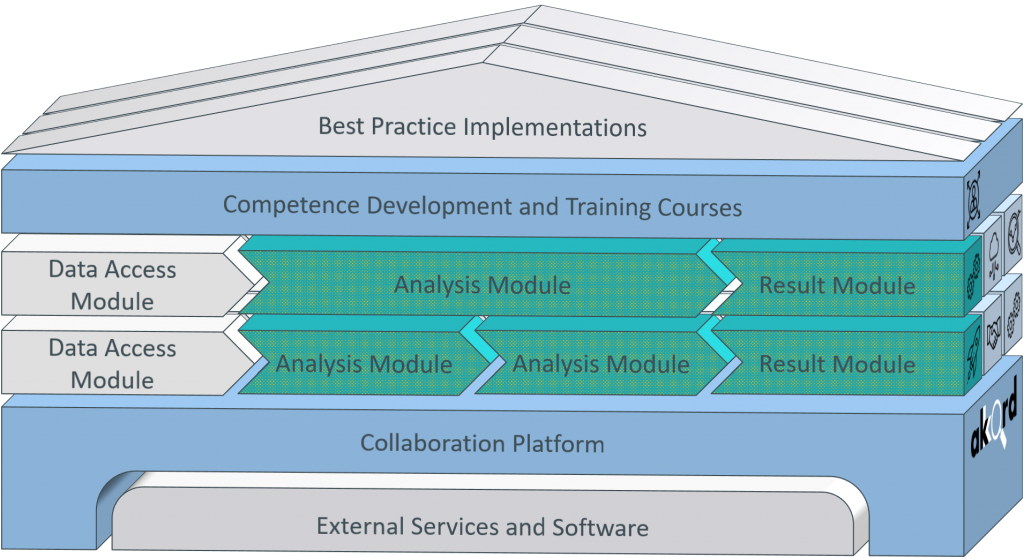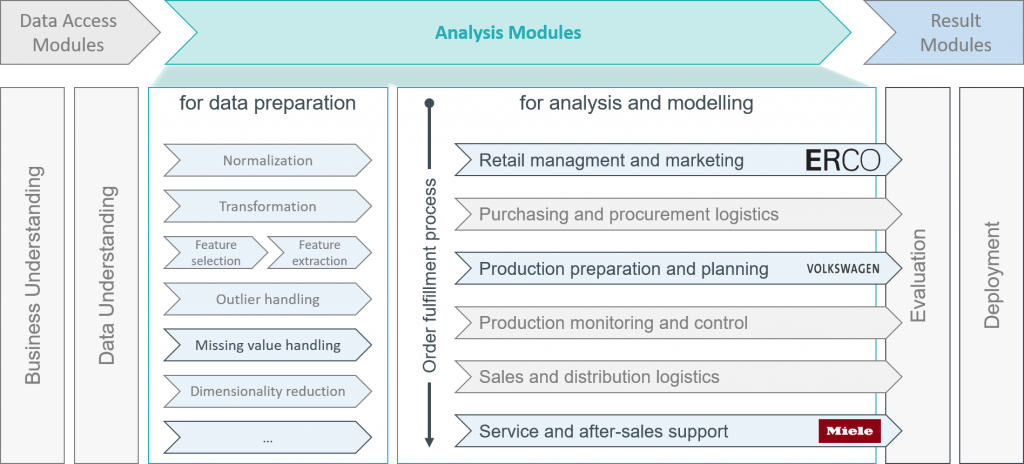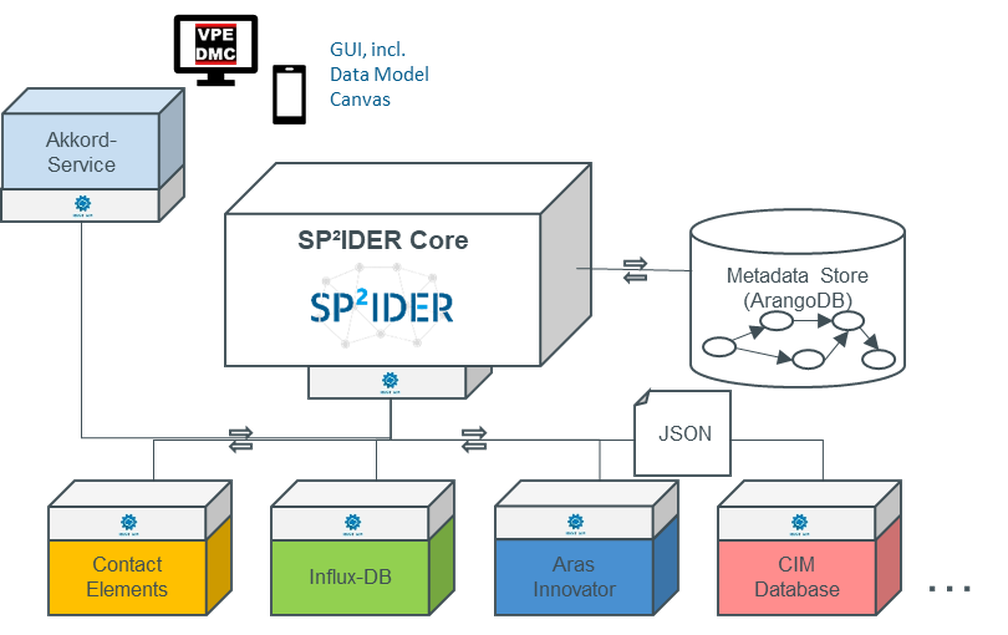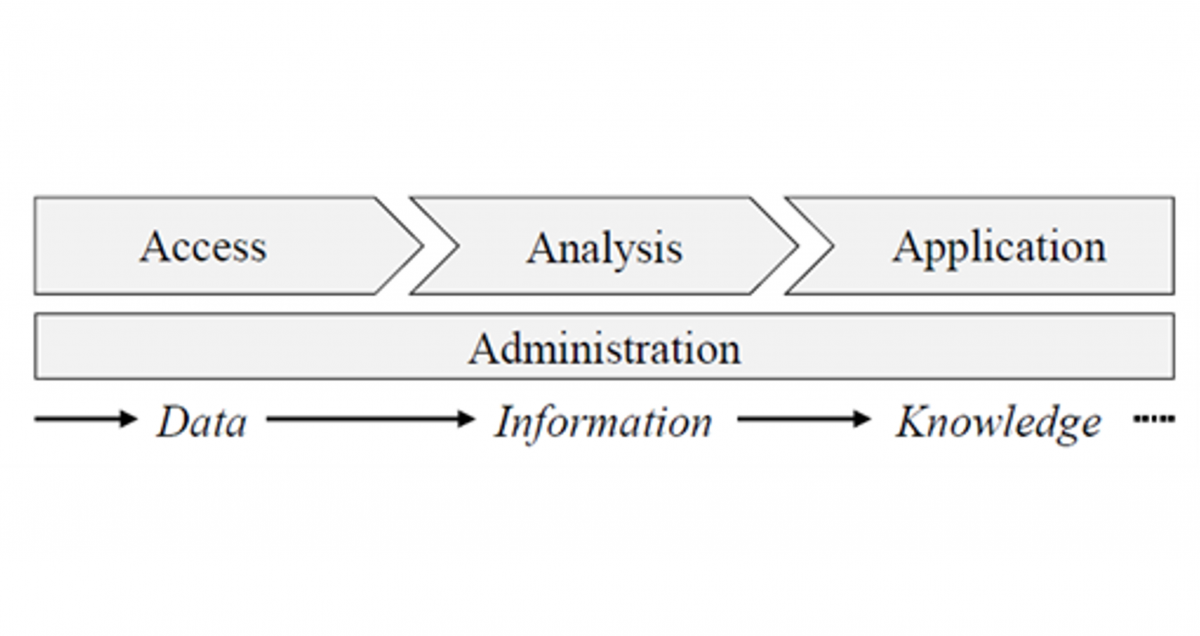First work report from the research area “Analysis Modules and Configuration” – Configuration of Analysis Modules
In this area of the project, analysis modules for networked and integrated data are being developed in parallel with the project’s applied use cases. The conceptual work is based on the preliminary assessment of general and specific requirements. The practical implementations are carried out in close interaction with the application partners of the AKKORD use cases.
A general introduction to the considered research area
Since this is the first work report from the research area, a general overview of the activities is first given. The research activities in the area of “Analysis Modules and Configuration” are one of four major focus topics in the AKKORD project. This news article provides a summarizing overview of the planned Reference Toolkit as well as the four research areas. More detailed information can be found in the opening publication of the research project. The following figure additionally illustrates the different research areas in the overall context of the project.

In the field of analysis modules and configuration aspects, RapidMiner GmbH and the Institute of Production Systems (IPS) at TU Dortmund University are leading the work on the required partial solutions of the analysis modules for a reference kit for value-creating, competence-oriented collaboration in dynamic value networks (here you can find an overview of the Reference Toolkit from the 4th consortium meeting).
By applying supervised and unsupervised learning methods as well as necessary preprocessing steps in the applied use cases of Volkswagen, Miele, ERCO, (Brabant & Lehnert) and DFKI, practice-relevant solutions are developed. The work is supported by AREND, PDTec and VPE, which are particularly focused on configuration aspects for integration in the Reference Toolkit. On the AKKORD use case websites, the use case implementations are described in more detail and the development of the solutins is presented.
Approach to the collaborative development in the research area
The extensive group of participating consortium partners illustrates the importance and complexity of the project’s implementation. For a well coordinated and yet parallelized development, the tasks and responsibilities in the consortium are divided according to the partner groups:
The application partners focus primarily on the immediate solution of data-driven questions and problems. The participating research partners design the conceptual framework and implementation options for the interaction in a reference toolbox. The development partners push for a generalization and transferability of the questions from a pilot implementation to a broad user community. A common task of all partners is the abstraction of the developed contents as well as the identification and further development of additional implementation scenarios.
Additional developments are being sought so that data analyses can also be used for SMEs in value networks at a reasonable time and effort:
- By establishing a configuration concept for automated model building and data analysis, uniform analysis modules are to be developed and made usable.
- The development of a module for the individualizable, automated generation of analysis dashboards is intended to enable individualizable solutions for practical in-field deployment.
- With the help of a user-oriented configuration assistant for data analysis, use case-dependent preconfigurations for modular analyses are to be made.
With the help of these developments, the “Analysis Modules and Configuration” serves as a key area for the implementation of the overarching Reference Toolkit.
Implementation of modular analysis through building blocks in the Reference Toolkit
Reference models are used to describe various issues, such as the SCOR model for supply chain processes or the ISO/OSI layer model for network protocols. The core idea of reference models is expressed by the following definition in the Gabler Online Lexicon:
“A reference model is a model or purpose-oriented partial representation of reality to achieve reuse of model properties” [according to Gabler]”
This article in the Encyclopedia of Information Systems discusses the various uses of reference models in more detail. In the AKKORD project, too, a reference model is developed as a construction kit that represents the planned implementations as individual building blocks. We call it a Reference Toolkit. The following graphic shows the current processing status of the model planned in the AKKORD project and highlights the relevant building blocks of the “Analysis Modules and Configuration” research area in color.

At the center of the diagram, located between the collaboration platform and competency development, are three types of building blocks:
- Data access modules
- Analysis modules
- Result modules
With the help of Data Access Modules, tasks such as the connection to a database, access to data-supplying web services or the import of data from an IT system (e.g. ERP system) are to be fulfilled. While these data access modules are being developed under the leadership of VPE and Contact in the “Data Backend System” service area (a news article is planned for publication in February 2021), the development of analysis and result modules represents the core aspect of the “Analysis Modules and Configuration” service area.
Based on a comprehensive data connection provided by the data access modules, the Analysis Modules provide modular implementations for data analyses. The modules are preconfigured for the targeted solution of practice-oriented tasks. Only company-specific parameters need to be adapted. Their tasks include, for example, linear or non-linear regression, the application of machine learning methods for predictions or the evaluation of process data in key figures.
Generated results of the analysis modules are presented with the help of result modules and thereby provided to the end users in a comprehensive form. This includes, for example, the visualization of model results (see also the following AKKORD publication), the generation of customizable analysis dashboards or the configurable representation of possible in-service systems.
The figure below shows an insight into the planned breakdown of the analysis modules.

First, a separation of analysis steps is made between preprocessing and model building and analysis. In order to develop practical analysis modules, the modules are divided into six categories along the order fulfillment process:
- Retail management and marketing,
- purchasing and procurement logistics,
- production preparation and planning,
- production monitoring and control,
- sales and distribution logistics, and
- service and after-sales support.
In the AKKORD use cases, the practical implementations of the analysis modules are developed and made usable in a generally applicable form for external users. Even if a clear assignment of the phases is not always possible, we broadly assign our use cases to the presented phases.
Practical components of the configuration concept for the creation of building blocks
In addition to the technical aspects of information exchange between analysis modules, the configuration concept includes three important components that are intended to ensure simple selection and configuration of the modules as well as long-term use of the reference module.

- Module Profile: Each planned and implemented analysis module is described by a module description, which specifies the specific benefit of the module, the necessary input and output values, and the parameters to be set for the analysis.
- Modul Guide: Since the concrete development of analysis building blocks in AKKORD necessarily requires processing in the use cases, relevant building blocks are also designed with the help of instructions and made available to future users for piloting.
- Modul Catalog: As a directory of all implemented analysis modules as well as all designed module instructions, the module catalog provides a register with categorized analysis modules that enables uses in operational sub-processes and departments.
In addition to these elements, the configuration concept defines the sequence, possible combinations or variation options of the analysis modules. It ensures the function and design of the analysis processes from both a business and technical perspective. The results are developed in close cooperation with the application partners to ensure practicality and low-effort use.
Summary and outlook on further research objectives
The configuration concept and the components presented represent one half of the measures for configuring analysis modules. In the next project year, the second half will be completed with the completion of work on a user-oriented configuration wizard. This wizard will provide previously unavailable solutions for user-oriented and application-specific creation of analysis processes and dashboards.
In addition, the practical implementations in the use cases will also be completed. Further information and interim results will be published continuously on the AKKORD website and in the news articles.
Darüber hinaus werden auch die praktischen Umsetzungen in den Anwendungsfällen abgeschlossen. Auf der AKKORD-Webseite und in den News-Beiträgen werden dazu kontinuierlich weitere Informationen und Zwischenergebnisse veröffentlicht.
Author und Contact Person:





